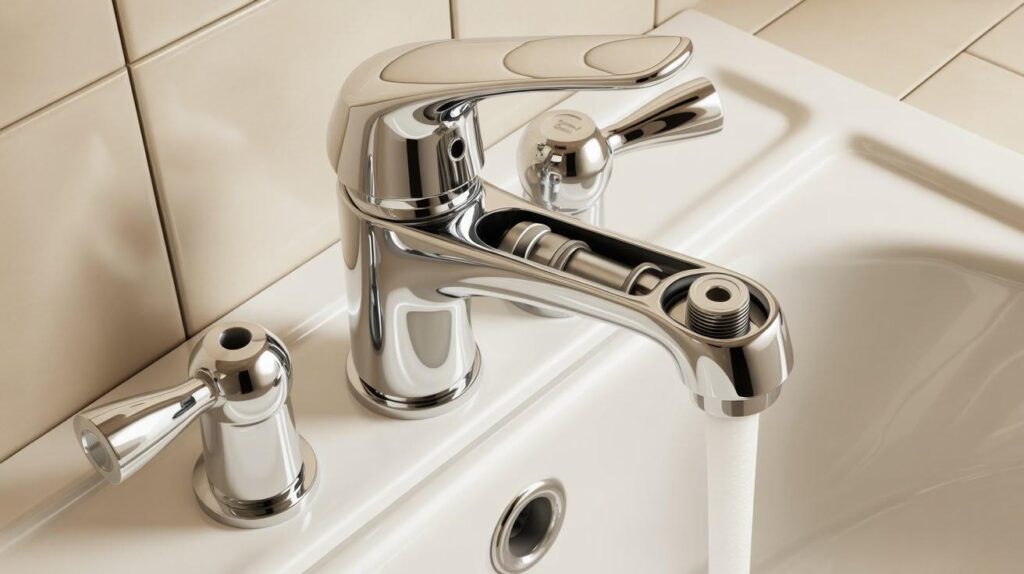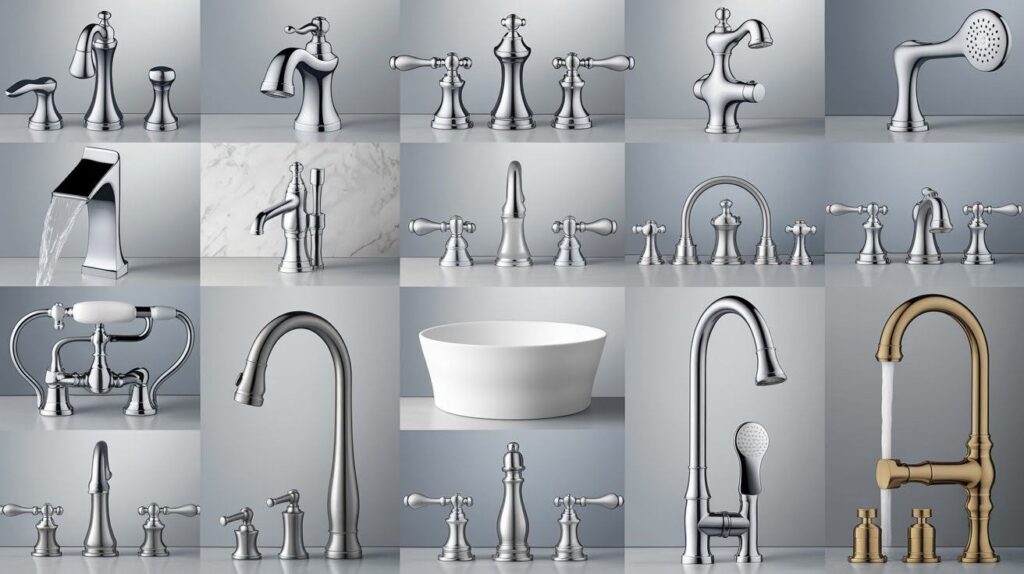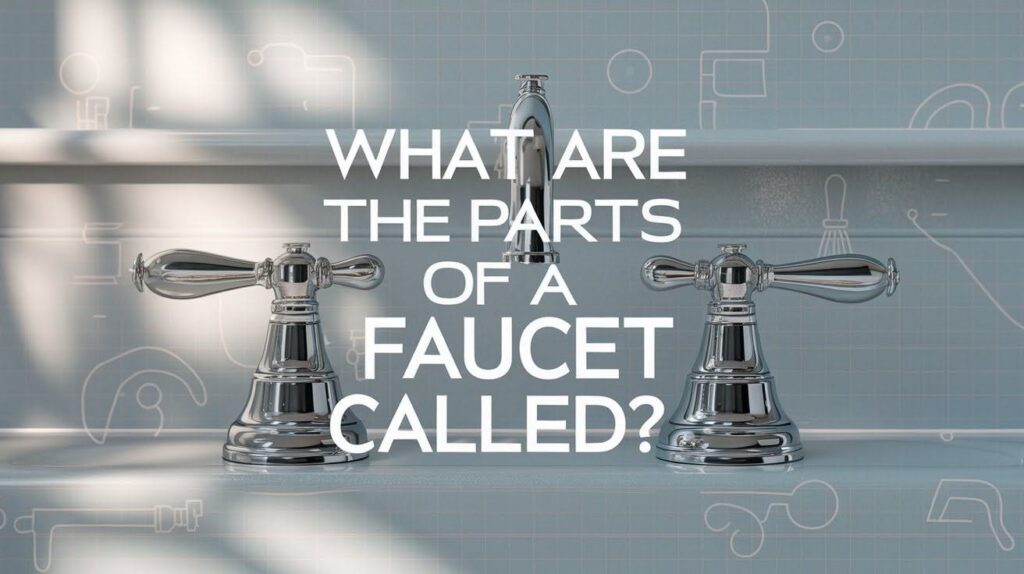Have you ever stared at a leaking faucet and wondered what goes wrong inside? I’ve been there too. Knowing what the parts of a faucet are called makes fixing problems so much easier.
You don’t need to be a plumber to understand your faucet. This guide will show you each component and what it does.
I’ll walk you through the spout, handle, valves, aerators, and more. You’ll learn to spot problems faster.
You’ll save money on repairs. And you’ll feel confident talking to professionals when you need help.
Let’s break down your faucet piece by piece.
What Is a Faucet?

A faucet is a device that controls water flow from your plumbing system into sinks, tubs, and showers. Understanding the basics helps you use and maintain them better.
A faucet is a valve you can turn on and off. It controls how much water comes out and how hot or cold it is. Think of it as a gate for your water supply.
When you turn the handle, parts inside move to let water through. Hot and cold water mix inside the faucet body. The handle position sets the temperature and flow rate.
Common types include compression, cartridge, ball, and ceramic disc faucets. Some have one handle while others have two. Each works similarly but fits different installations.
The Essential Parts of a Faucet

Every faucet has basic parts that work together to control water flow. Understanding these components helps you fix common problems and keep your faucet running smoothly.
Spout The Pathway for Water to Exit: The spout is where water comes out. It’s the curved or straight tube extending over your sink. Some spouts swivel while others stay fixed in place.
Handle Controls Water Flow and Temperature: Handles let you turn water on and off. They also control temperature. Single-handle faucets have one lever. Double-handle faucets have separate controls for hot and cold water.
Valve / Cartridge The Mechanism That Turns Water On and Off: This part sits inside your faucet handle. When you move the handle, the valve opens or closes to let water through. A worn cartridge causes drips and makes handles hard to turn.
Aerator Mesh Screen That Softens and Regulates Water Stream: The aerator screws onto the tip of your spout. It mixes air with water to create a smooth stream. Unscrew it and rinse it clean when water pressure drops.
Supply Lines Tubes That Carry Hot and Cold Water: Supply lines connect your faucet to the water pipes in your wall. Most are flexible tubes made of braided steel or plastic. Check these regularly for leaks.
Internal Faucet Components Explained

Different faucets use different internal systems to control water. Knowing which type you have helps you find the right replacement parts and fix problems correctly.
Compression Valve Found in Older Faucets
Compression valves use a rubber washer that presses down to stop water flow. You turn the handle several times to open or close it fully.
These are common in older homes. The washers wear out and need replacing often. That’s why compression faucets drip more than modern types.
Ball Valve Rotating Ball Used in Some Single-Handle Faucets
A ball valve has a round metal ball with holes in it. When you move the handle, the ball rotates. Water flows through the holes when they line up with the inlet.
This design works well but has more parts that can wear out. Springs and rubber seals inside need occasional replacement.
Cartridge Smooth, Modern Flow Control System
Cartridge faucets move smoothly with little effort. Inside is a hollow cartridge that slides up and down to control flow. It also rotates to adjust temperature.
These last longer than compression valves. When a cartridge fails, you replace the whole unit instead of individual washers.
Ceramic Disc Mechanism Durable, Long-Lasting Technology
Ceramic disc faucets are the most reliable modern option. Two ceramic plates slide against each other to control water. These plates are extremely hard and resist wear.
You rarely need to replace them. They handle hot and cold water mixing with precision. Most high-quality faucets use this technology now.
Types of Faucets and How Their Parts Differ

Faucet designs vary based on sink setup and personal preference. Each style uses similar basic parts but arranges them differently to match specific installations.
Single-Handle vs Double-Handle Faucets
Single-handle faucets control both temperature and flow with one lever. They’re simple to use and take up less space. Double-handle faucets have separate hot and cold controls.
They offer more precise temperature adjustment. Single-handle units usually need cartridge replacement. Double-handle models often just need new washers or O-rings.
Centerset vs Widespread Faucets
Centerset faucets have handles and spout connected in one unit. They fit sinks with holes four inches apart. Widespread faucets have separate pieces for each handle and the spout.
These fit sinks with holes six to sixteen inches apart. Widespread faucets look more custom but cost more.
Wall-Mounted Faucets
These faucets attach to your wall instead of your sink. The valves sit inside the wall behind finished trim. Wall-mounted styles work well with vessel sinks or freestanding tubs.
They free up counter space. Installation is more complex because you need access behind the wall.
Roman Tub & Vessel Sink Faucets
Roman tub faucets mount on the tub deck rather than the wall. They often include a hand shower attachment. Vessel sink faucets sit taller than standard faucets.
The extra height accommodates sinks that sit on top of the counter. Both styles need longer spouts to reach properly.
Specialty Faucets (Waterfall, Touchless, Sensor-Controlled)
Waterfall faucets have wide, flat spouts that create a sheet of water. Touchless faucets turn on when you wave your hand near a sensor. They need batteries or electrical power.
Sensor-controlled models reduce water waste. These specialty types use standard internal parts but add extra components for their unique features.
How to Identify Faucet Parts During Repairs
Spotting which part has failed saves time and money on repairs. Learning to recognize common problems helps you fix issues fast.
A bad cartridge makes your handle stiff or loose. Water won’t shut off completely. Look for cracks or mineral buildup and replace it.
Water dripping under the handle means O-ring failure. Check if they feel soft and springy. Replace hard or flat ones.
Low water pressure usually means a clogged aerator. Unscrew it and rinse away white or brown buildup.
A wobbly faucet means loose mounting nuts. Get under your sink and tighten them.
Check supply lines for bulging, cracks, or wet spots. Tighten connections or replace old lines with braided steel.
Maintenance Tips for Each Faucet Component
Regular care keeps your faucet working smoothly for years. Simple maintenance prevents expensive repairs and extends the life of every part.
- Remove and clean your aerator every few months. Soak it in white vinegar overnight for tough buildup. Replace it every few years or when cleaning doesn’t restore flow.
- Run hot water through your faucet weekly to flush sediment. Install a water softener if you have very hard water. Remove and clean cartridges annually to prevent sticking.
- Apply plumber’s grease to O-rings when replacing cartridges or doing repairs. This keeps rubber soft and flexible. Don’t use petroleum jelly as it breaks down rubber over time.
- Check supply lines twice a year for rust, cracks, or soft spots. Replace lines every five to seven years. Braided steel lines are safer than plain rubber.
- Wipe your faucet dry after each use to prevent water spots. Clean with mild soap and a soft cloth. Never use abrasive cleaners or scrub pads as they scratch protective coatings.
Conclusion
Understanding what the parts of a faucet are called gives you real power in your home. I learned this after my first kitchen leak.
Knowing the difference between a cartridge and an O-ring saved me hundreds in plumber fees.You can handle basic repairs yourself now. You’ll spot problems early.
And when you do call a professional, you’ll know exactly what needs fixing. Start by checking your aerator this weekend. It’s the easiest win.
What part of your faucet gives you the most trouble? Share your experience in the comments below. And if this guide helped you, pass it along to someone fixing their own sink.
Frequently Asked Questions
What is the most important part of a faucet?
The valve or cartridge is the most critical component. It controls water flow and temperature. When this part fails, your entire faucet stops working properly.
How do I know which faucet parts I need to replace?
Look at where the problem occurs. Drips from the spout mean bad O-rings or cartridge. Leaks at the base mean worn gaskets. Low pressure points to a clogged aerator.
Can I replace faucet parts myself or do I need a plumber?
Most faucet repairs are manageable for homeowners. Replacing aerators, O-rings, and cartridges requires basic tools and patience. Call a plumber for supply line issues or corroded parts.
How often should I replace faucet parts?
Aerators need replacement every two to three years. O-rings and washers last one to three years. Cartridges can last five to ten years. Replace supply lines every five to seven years.
Why does my faucet drip even after replacing parts?
You might have installed parts incorrectly or missed a worn component. Check that O-rings are seated properly and the cartridge is oriented correctly. Mineral buildup can also prevent proper sealing.

